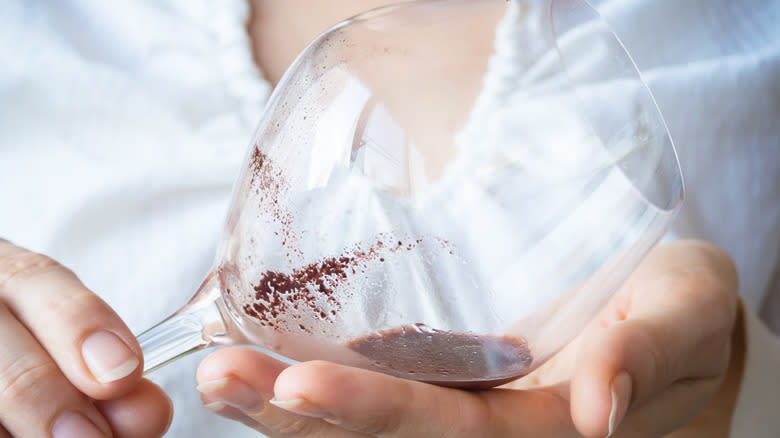The Coffee Filter Hack To Use On Wine With A Lot Of Sediment

If you've ever taken a swig of wine and been welcomed to a mouthful of gritty little pieces of what feels like sand, you know how unpleasant wine sediment can be. It isn't bad for you, but you aren't really drinking wine for the health benefits. No, wine is for pleasure and all these little crystals are getting in the way.
In the old days, people would pull the bottle of wine off the cellar rack a week before they planned on opening it to allow the sediment to sink to the bottom. They would carefully pour it so as not to disrupt that bottom layer, which they would leave in the bottle unpoured. This still works if you plan ahead but won't help you if you're a spontaneous drinker. It also comes with the unfortunate loss of the wine left in the bottle.
Thankfully there's another way. Coffee filters are designed to hold finely ground coffee while allowing the water to pass through which is exactly what we're trying to do with our wine -- catch the fine sediment while letting the wine come through. You'll ideally want to use a thick, unbleached coffee filter to avoid altering the taste. Run some water over the filter before using it if you want to go the extra mile. If you have a decanter, feel free to pour the entire bottle through at once. Alternatively, you can hold the coffee filter over the wine glass and only pour what you need.
Read more: 13 Liquors Your Home Bar Should Have
Why Does Sediment Form?

Not all wine has sediment in it. Sediment is essentially tiny solids that have accumulated in the wine. They can be pieces of the grape, dead yeast cells, tartrates, or the product of a natural chemical reaction that accumulates over time. Just to reiterate, none of these are going to make you sick. You will more often see sediment in red wine compared to white or rosé, especially in red wine that has been on the shelf for 10 years or more.
Some wineries will filter all of this out before bottling the wine. One way they do this is by cold stabilizing the wine, which is when they cool the wine down to induce the particles to form prematurely. They then filter it for you. There's another method called fining, where they put an additive into the wine such as egg white, clay, or pea powder which attracts all the sediment to it. The cluster is then removed from the bottle, leaving you with sediment-free wine.
Some people prefer wine with sediment because it feels more natural, but it's by no means a universally held opinion. Funny enough, the more expensive the wine, the more likely you are to find sediment inside.
Read the original article on Tasting Table.

